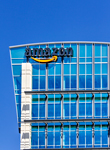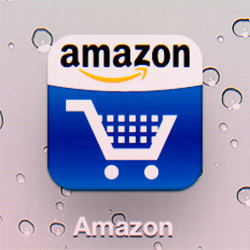By Kevin Zimmerman

Amazon.com, the multi-tentacle e-commerce site, has long lived by the shark model: If it does not continue to move, or in this case expand, it may die. Historically unable to show an actual profit over its 21-year-history – a sure sign of death for most retailers – Amazon has instead focused on pure revenues: $88.988 billion worth at the end of 2014.
But even the “it has never shown a profit” truism seemingly no longer has legs. Second quarter results announced at the end of July revealed a profit of $92 million on sales of $23.18 billion – as compared with a $126 million loss for the same period last year. Not a huge figure – Google showed a $3.93 billion profit for the quarter, while eBay reaped $682 million – but certainly better than what most analysts, who had forecast a loss, had expected. In addition, Amazon said it anticipates third-quarter revenue of $23.3 billion to $25.5 billion, which would be an increase of 13-24 percent year-over-year.
What has stayed consistent throughout is the so-called “Amazon effect” felt by retailers worldwide, most famously in the book-selling space. There, its practice of underpricing its competition ultimately spelled doom for the Borders chain, which once outsourced its online book selling to Amazon only to finally collapse into bankruptcy in 2011. Innumerable independent bookstores also vanished in the face of such competition, with only the Barnes & Noble chain left as Amazon’s chief competitor. The difference between B&N and Amazon? On August 4, 2015, B&N was trading at $17.83 a share, compared to Amazon’s $532.13.
Enter AmazonBusiness
In addition to Amazon’s foundational retail business where it sells directly to consumers (B2C), it also allows third-party sellers the virtual real estate to offer their own inventory to consumers. If those orders are not fulfilled by Amazon, the order is fulfilled directly by the seller, who is also responsible for customer service.
Amazon’s latest move forward came on April 28, when it formally announced the launch of AmazonBusiness, a business-to-business platform that seeks to seize a presumably ever-larger piece of the estimated $7.2 billion B2B pie. Amazon Business is replacing its prior attempt to crack that marketplace, AmazonSupply, by – wait for it – offering much, much more.
Dick Friedman, owner of Chicago-based General Business Consultants, is not thrilled. “Do sellers need to be frightened? Yes,” he says. The main point of concern, he maintains, is the seller’s loss of the face-to-face relationship with his or her buyers – something to consider within both the B2C and B2B realms. “Joining AmazonBusiness could lead to diminishing or losing those relationships,” he says. “If you are a storefront retailer, anything you sell through Amazon usually does not create or enhance a relationship with a customer.”
Friedman brings up another potential boogeyman for B2C sellers. “If a certain product or product line becomes successful, Amazon could start to stock it themselves, from other sellers,” he cautions. “That remains to be seen, but I suspect that one day they will.”
Indeed, a 2012 Wall Street Journal story pointed out examples of just that. Garden Grove, California-based sports merchandise company Collectible Supplies, Inc. had been selling up to 100 of its NFL mascot “pillow pet” items on Amazon at $29.99. Just as Friedman outlined, Amazon soon began selling the same product, utilizing preferred webpage placement. Collectible Supplies owner Jeff Peterson tried remaining competitive by lowering his price, but told the Journal that Amazon “would always match my price or go lower until I eventually gave up.”
Peterson has since split the difference: While his store sells some team-specific pillow pets on Amazon, he offers an entirely different Major League Baseball-themed pillow pet product on his own site.
The shark, meanwhile, continued to swim on.
A Mixed Picture
Like it or not, more and more businesses are, like consumers, shifting more of their spending online. Of course, nearly every successful business maintains a website these days. But differentiating one’s inventory from competitors – already a longtime challenge – becomes even more so when it comes to online, which increasingly means Amazon.
If a brick-and-mortar or online retailer or wholesaler is feeling threatened, Friedman says, “They should increase their supply of profitable, specialty products and decrease their other commodities. They should also start to think about value-added services for which they can charge a fee.”

Such services – installation, delivery, repair, training, and the like – will help independents differentiate themselves from their local competition as well as from the Amazons of the world, who have not gotten around to offering installation of electronics or appliances, at least not yet. The other tried-and-true method of reducing one’s overhead is, as always, downsizing. “It may be emotionally difficult to consider layoffs,” Friedman allows. “But if competition from Amazon, eBay or others is continuing to have an effect, your having fewer employees can help save your bottom line.”
In the meantime, Amazon’s employee base grew by 31 percent in 2014 to 154,100. The company has over 90 “fulfillment centers” a.k.a. warehouses around the U.S., and analysts at investment bank/asset management firm Piper Jaffray estimate that those centers’ locations bring Amazon within 20 miles of 31 percent of the population, as well as within 20 miles of 50-65 percent of its same-day addressable market. Same-day delivery is available in New York City, Atlanta, Baltimore, Boston, Chicago, Indianapolis, Philadelphia, Washington D.C., Dallas, Los Angeles, Phoenix, San Francisco, and Seattle.
Using a barcode system, Amazon ships products to customers from its nearest fulfillment center to minimize delivery time. That is great for consumers, but potentially not so wonderful for third-party sellers. If a customer in Chicago orders an item from a seller located in Phoenix, Amazon may swap in an identical product from Indianapolis to ensure swift delivery.
While the Phoenix seller gets credit for the sale in this example, there are documented cases of things not exactly working out as planned. Inferior or downright counterfeit products have been delivered to unsuspecting customers, despite Amazon’s diligence. The company does its best to remedy the situation, but negative customer reviews usually end up on the Phoenix seller’s page, not the Indy-based one. It is hard for a store’s reputation to bounce back from something like that.
Long term?
Having only launched in late April, it is still too early to ascertain Amazon Business’ adoption or success rates. Gartner’s Daigler notes, however, that “Amazon’s tactics are often copied, so if they experience significant success with Amazon Business, I would expect others to follow.”
Though hardly scientific, an online readers’ poll by website EcommerceBytes over whether or not to join Amazon Business resulted in universally negative opinions. “Amazon is much too restrictive as to the categories I can sell in, their listing process is exhaustive and includes too many things that do not apply,” wrote one respondent. “Their commission is outrageous and they set the amount I can charge for shipping, which is way less than actual cost in most cases.”
Wrote another: “If I wanted to be lead around I would buy a collar and chain at my local hardware store.”
The main points to keep in mind when considering joining Amazon Business:
• The type of merchandise one is selling. Not everything can be boxed and shipped via bubble-wrap and cardboard; if one is selling such items as refrigerators or bathtubs, forget it. “Amazon is set up to sell millions of items,” Friedman says, “but not very large or heavy items.”
Those looking to purchase from Amazon Business should also consider the cost-to-benefit ratio. Amazon Business may deliver what a business owner wants at an attractive price, but is that all there is? Again, local vendors are more likely to be immediately available for service, and many offer “frequent flyer” rewards programs and/or financing options that are unlikely to be found on the Amazon Business site.
For its part, Amazon is – as ever – content to play the waiting game. “We are willing to plant seeds that take time to grow,” the company’s founder and CEO Jeff Bezos has said. “We do not focus on the optics of the next quarter; we focus on what is going to be good for customers.”
If all this has not given traditional retailers enough to think about, consider this: In February, Amazon opened its first ever brick-and-mortar store. Located on the campus of Purdue University in West Lafayette, Indiana, it is small potatoes so far, essentially serving as a student pick-up and return service for textbooks and the like.
Still, the company has indicated it could open four or five other stores this year, which may include a decidedly non-university-targeted one in New York City, where it holds a lease on the first floor of a space opposite the Empire State Building.
What does it all mean? “We are willing to be misunderstood for long periods of time,” Bezos once cryptically told Forbes.
Somewhere, a shark is smiling.
